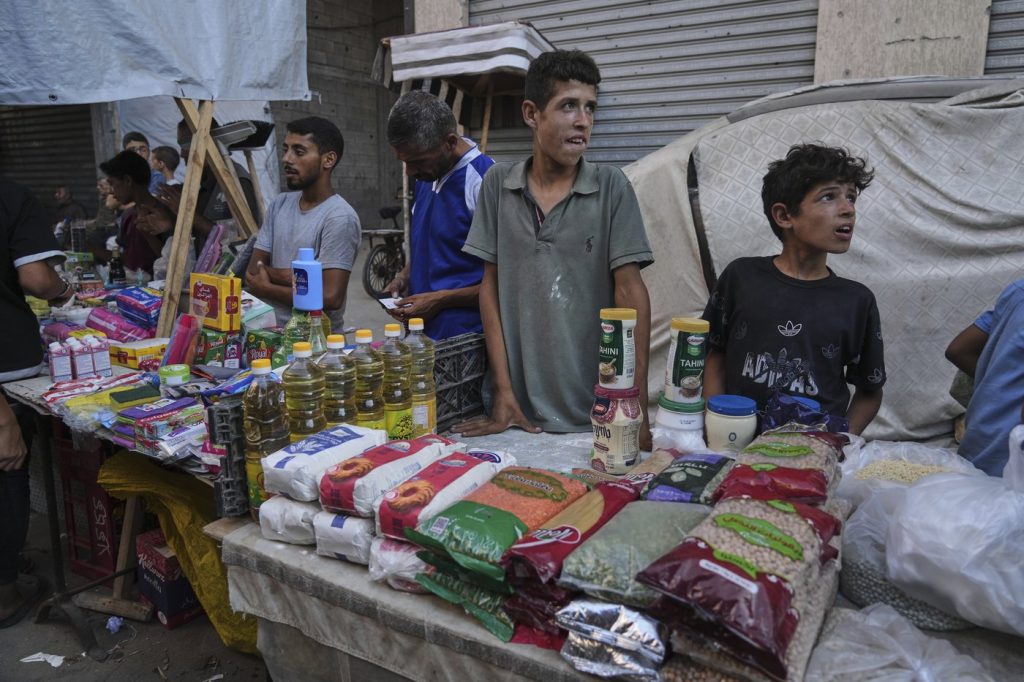DEIR AL-BALAH, Gaza Strip (AP) The ongoing conflict in Gaza has exacerbated a dire humanitarian crisis, leading to severe food shortages and inflated prices. Since Israel's recent military offensive, which has disrupted security structures within Gaza, delivering aid has become increasingly perilous. With food supplies dwindling, aid meant for Palestinians is often hoarded by gangs and local merchants, who then sell it at exorbitant prices, making basic necessities unaffordable for many.
In recent days, the cost of essential items has skyrocketed; a kilogram of flour has reached prices as high as $60, and lentils have been observed selling for $35. This situation has placed a significant strain on the majority of Gaza's residents, who are already facing the threat of famine and are heavily reliant on their dwindling savings. Reports indicate that as many as 100,000 women and children in the Gaza Strip are suffering from severe acute malnutrition, and hunger-related deaths have been reported over the last three weeks.
On the weekend, Israel responded to international pressure by agreeing to facilitate more aid deliveries, leading to a slight decrease in food prices. However, the effects of this policy shift have not yet been fully realized on the ground. Despite attempts to distribute aid through U.N. channels, deliveries are frequently met with chaos, as armed gangs often attack convoys or overwhelm aid workers. The World Food Program (WFP) has indicated that it will only be able to effectively deliver aid to the most vulnerable populations once internal security is restored, which is likely contingent upon a ceasefire.
In an alternative aid delivery system, the Gaza Humanitarian Foundation (GHF), established with the intent of preventing aid diversion by Hamas, is also experiencing significant challenges. Reports indicate that more than 1,000 Palestinians have been killed by Israeli troops while seeking food, primarily near GHF distribution points, as security forces often open fire to control crowds. This highlights the extreme risks involved for those attempting to access necessary food supplies, where the strong often overpower the weak in desperate attempts to secure aid.
Footage from GHF distribution sites showcases disturbing scenes of chaos, with crowds frantically racing to collect boxes of aid. GHF has implemented separate lanes for women and children in response to the violence, but reports suggest that armed individuals are stealing aid from recipients, exacerbating the crisis further. Individuals who have visited these sites frequently report the necessity of being both strong and fast to procure food items, indicating a troubling reality where survival often means outpacing others.
The U.N. has not accepted protection from Israeli forces, preferring to rely on community support amidst increasing violence. The Israeli military has denied permitting looting in areas under its control and attributes the ongoing crisis to Hamas's refusal to surrender. Despite calls for Israel to fully lift the blockade and increase aid to alleviate the humanitarian situation, talks surrounding a potential ceasefire have stalled, leaving civilians trapped in a cycle of violence and deprivation.
Israel's efforts to limit aid delivery began to change in May when it allowed a small number of trucks into Gaza. However, the average of 70 trucks permitted daily falls far short of the 500-600 trucks the U.N. estimates are necessary to effectively address the ongoing humanitarian crisis. As the situation continues to evolve, addressing the chaotic and violent environment surrounding aid distribution remains crucial for the well-being of the affected populations.
Overall, the complexities of the conflict and the dire humanitarian needs underscore the urgent necessity for a comprehensive solution that would allow for the safe and equitable distribution of aid in the region.










